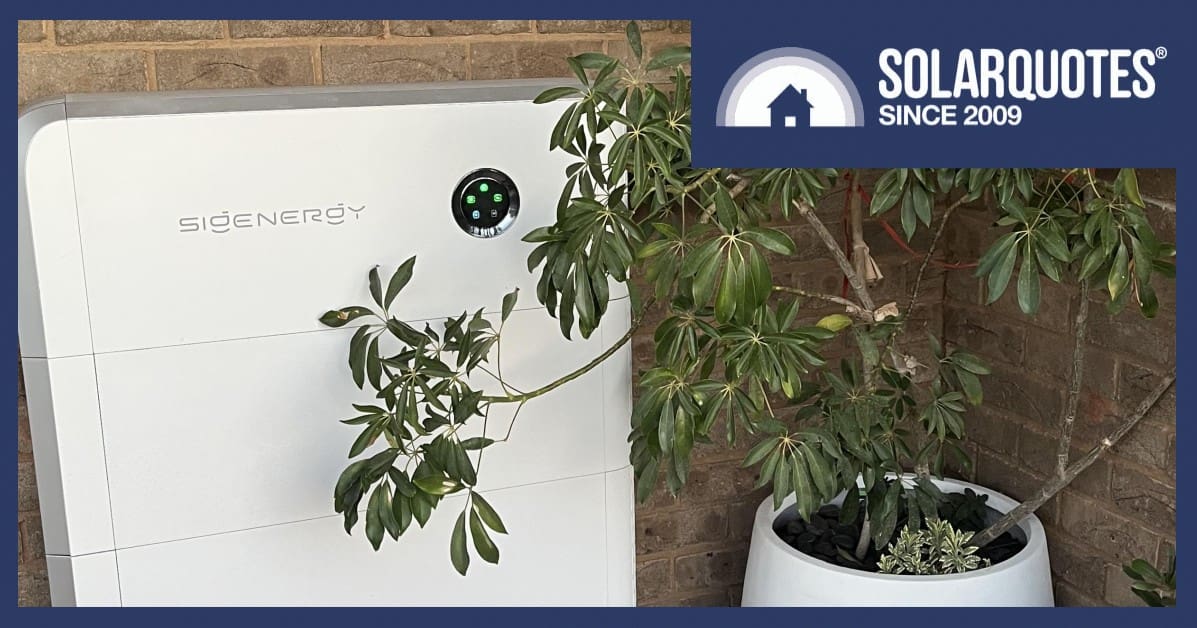
A Sigenergy home battery installed by Stag Electrical Solar and Refrigeration ACT.
Home batteries lower greenhouse gas emissions.
Unless, of course, you’re a complete nutter and use a battery to deliberately raise them in an attempt to cook the planet. But this ruins the savings, so only a complete loony would try it.
Below, I’m going to explain the two main ways home batteries reduce emissions — directly through normal use, and indirectly by making it easier to add more renewable generation and close down coal power stations. I’ll also explain why you shouldn’t charge your battery from an overnight off-peak rate if you care about emissions. That is, if you care about reducing them.
And if you are a complete nutter, then you should read on so you can do the opposite.
How Do Home Batteries Lower Emissions?
Home batteries store clean energy that can be used later in place of fossil fuels. The clean energy normally comes from rooftop solar, but can come from the grid. When discharged at night, batteries almost always reduce coal and gas generation.
If power from rooftop solar is used to charge a home battery rather than sent into the grid, this can raise emissions by causing coal and gas generators to increase output to make up the difference. But thanks to expanding solar capacity, it’s becoming increasingly likely that charging a home battery will simply prevent clean energy from going to waste, rather than boost fossil fuel generation.
In normal use, a home battery decreases emissions by more than it occasionally increases them. But that’s not their only benefit. Home batteries also indirectly cut emissions by making it easier to add more solar and wind capacity to the grid, while hurting the economics of coal and gas generation. Because they can supply power on demand, with enough battery capacity and solar panels to charge them, entire coal power stations can — and will — be closed down.
SA Leads The Way
The state getting the largest portion of its electricity from solar and wind, and with the most battery capacity per person, is South Australia. Above is a graph from Open Electricity showing its consumption on Saturday, October 18. Rooftop solar, displayed in light yellow, produced enough power to meet the state’s entire electricity demand around noon. There was also a considerable amount of wind power, shown in green, which allowed power to be exported to Victoria late at night and contributed to exports during the day. Battery power is dark blue, and you can see it meeting demand in both the early morning and the late afternoon and early evening. At 7:00 pm, Adelaide time, batteries met 28.6%1 of state demand, which is close to a world record. California has gone higher than that, but Californians being high is nothing new.
Gas generation is various shades of orange. The only reason any was used in the middle of the day or late at night was because it was used to help provide grid stability. While gas consumption rose in the evening, it remained much lower than it would have been, thanks to battery power.
What the graph doesn’t show is that, at around noon, several hundred megawatts of solar power that could have been generated weren’t. This clean generation was curtailed, which means it was intentionally reduced. So if a home battery was charged while clean energy was effectively going to waste, it wouldn’t have resulted in any increase in fossil fuel generation. Instead, it would have resulted in less solar energy being wasted.
While South Australia is ahead, it won’t be long before all states are regularly meeting over a quarter of their demand with batteries, and those batteries will mostly be charged with solar energy.
Solar’s Effect On Emissions
Australia has lots of sunshine and plenty of solar panels. Over the past year they provided 21% of Australia’s electricity. Two-thirds from rooftops and the rest from large-scale solar farms. This clean daytime generation is a huge headache for coal power stations. Because shutting down and starting up again is expensive, coal generators are regularly forced to reduce output to the lowest level they can manage during the day for extended periods. At these times, they normally operate at a loss, while gas generation — which is much easier to start and stop — almost entirely disappears.
Below is another graph from Open Electricity, showing generation for Australia as a whole for Monday, September 29. It shows light yellow rooftop solar going strong in the middle of the day, along with dark yellow solar farms. Black and brown coal are forced to cut back during the day, but go strong at night. The orange of gas generation is barely visible during the day, while green wind and light blue hydro contribute during the day and night. Because there was some rain, there’s more hydro generation than usual.
Power from batteries discharging is dark blue and, for a short time, they met over 7% of Australia’s power consumption on this Monday evening.
The daytime solar surge greatly reduces average emissions per kilowatt-hour (kWh) generated. The graph below, also from Open Electricity, shows NSW’s emission intensity over the same period as the graph above. Using Australian Eastern Standard Time, it ranges from a high of 0.721kg of CO2 per kWh at 3.30 am, to a low of 0.265kg per kWh during the day at 12:30 pm.
And here’s what it looked like in NSW over several days:
Emissions per kWh are reduced during the day, rise in the late afternoon, and remain high until an hour or so after sunrise. In Queensland and WA, emissions follow a roughly similar pattern. In Victoria, the pattern isn’t as strong, as it has the least solar and cloudiest weather of all mainland states. In SA, emissions in the day often drop close to zero, as this graph shows:
In Tasmania, there’s no real pattern at all, thanks to that state’s massive amount of hydro power and a considerable amount of wind generation. But solar still helps reduce emissions by allowing increased electricity exports to Victoria.
The average daytime emissions intensity in all states will only decline as more solar is installed.
Clean Energy Is Often Wasted
In NSW on Tuesday, September 30, the average emissions from 9 am in the morning to 3 pm in the afternoon averaged about 200g per kWh. From 5 pm in the afternoon to 7 am the next morning, the average was around 630g per kWh.
So, going by the averages, and ignoring losses, if a home battery was charged during the 6 hour daytime period and discharged in the 14 hour period starting in the late afternoon, each kWh of stored energy discharged would reduce emissions by 630g minus 200g, for a total reduction of 430g per kWh. While there may be times it works out that way, emission reductions will normally average higher than this because a considerable amount of clean energy, both solar and wind, is curtailed and effectively wasted.
The graph below shows South Australian generation over 4 days. On each day, there’s a considerable amount of rooftop solar generation, shown in light yellow. On the first day, Wednesday, there’s also a considerable amount of dark yellow solar farm generation. But on Thursday, there are clear signs of large-scale solar being curtailed, and on Friday and Saturday, it basically disappears in the middle of the day.
While curtailment of solar farm generation is common in South Australia, it also happens in other states. Wind power is also often curtailed. This happens for two main reasons:
- Insufficient transmission capacity: The grid isn’t able to get renewable energy to where it needs to go.
- Economic: Solar and wind farms will reduce or stop generation if it saves money.
If solar or wind power is being curtailed in your area, for either reason, then charging your battery won’t increase fossil fuel generation. Instead, it will cause renewable energy to be curtailed slightly less. Curtailment from insufficient transmission is most likely to let you charge without emissions in rural areas, while curtailment for economic reasons can occur everywhere.
Economic curtailment happens when wholesale electricity prices, which are what generators receive, go negative. This occurs when the grid receives too much power and, instead of being paid to supply electricity, generators have to pay to supply it. This provides a clear incentive to cut back.
It’s very easy for solar and wind farms to reduce output or shut down entirely, so if they’re not making enough to cover costs after all factors are considered, they will. But because it costs a fortune for coal power stations to stop and start, they normally operate at a loss in these periods. This means charging a battery during these times, whether from rooftop solar or the grid, won’t increase emissions because there’s clean renewable generation ready to take its place.
Solar and wind generation have no fuel cost, so if they are being curtailed, they’ll be brought back online before gas or coal are used, because both cost money. Even though Victorian brown coal is dirt cheap, digging it up is still an expense and mining royalties must be paid on every tonne.
In 2024, only about 2% of solar farm generation was curtailed for economic reasons. This isn’t a huge amount, but it mostly occurred around the middle of the day, and will increase over time. Wind power wasn’t curtailed by as much, but it still contributes to the amount of time batteries can be charged with zero contribution to emissions.
Update October 27, 2025: I wrote above that economic curtailment of solar farms in 2024 was only about 2%. But, as was kindly pointed out in the comments, it was more likely around 10%.
Rooftop Solar Also Gets Curtailed
While I only mentioned solar and wind farms above, rooftop solar can also be curtailed. This can be done through flexible exports, also called dynamic exports, which are common for new solar in SA and Queensland. They allow power from rooftop solar to be reduced when there’s more than the grid can easily accept. Also, if a house has a low or zero export limit, or simply has a large solar system, it can result in more solar power being produced than the home can use or export at the time. Regardless of the set up, charging a battery with solar power that would otherwise go to waste will not raise emissions.
Discharging At Night Cuts Fossil Fuel Generation
Here’s a graph showing Queensland electricity generation on Saturday, October 11, through to 7 am on Sunday morning:
From 8 am in the morning until 4 pm in the afternoon, each kWh of electricity consumed in the state resulted in average emissions of around 340g of CO2, while from 5 pm in the afternoon to 7 am the next morning, emissions averaged around 740g per kWh.
Going by averages, charging a home battery with 1kWh during the day would result in 340g of emissions, plus some extra from losses. With 90% roundtrip battery efficiency, the total emissions would average around 380g. Discharging that 1kWh at night would reduce emissions by 740g and subtracting the 380g from charging gives a net average reduction of 360g of CO2 for every 1kWh discharged.
But that’s not what would actually happen. When it’s not curtailed, large-scale solar in Queensland typically provides close to half as much energy as rooftop. So, on this day, large-scale solar was clearly being curtailed and charging a battery would likely have resulted in zero emissions or close to it.
Also, when a battery is discharged at night, it won’t reduce emissions by the average amount. Each 1kWh discharged will normally reduce fossil fuel generation by 1kWh. This is because wind power’s fuel — moving air — is free, so it wouldn’t be reduced. While it’s possible hydro generation would be reduced, that would just leave water in the dam that would later be used in place of fossil fuels. Gas generation has a high fuel cost, so if it’s being used at the time, its output is normally cut first. Coal has a low, but not free fuel cost, and so gets reduced after gas does.
In Queensland, gas generation averages around 515g of emissions per kWh, while coal averages around 960g. Discharging a battery on this Saturday night would have reduced gas generation up until 9 pm. After this time, there was barely any gas generation, so battery power would reduce coal consumption. Whether gas or coal generation was reduced, the emission reductions of around either 515g or 960g when the battery was charged on a day that clean energy was curtailed, are much higher than the 360g reduction that going by the averages gives.
Sometimes Battery Charging Will Increase Emissions
On the other hand, there will be times when charging a battery during the day will directly increase fossil fuel generation. The graph below shows NSW generation on Tuesday, October 7.
As there was little or no curtailment of renewables, using 1kWh of energy from rooftop solar to charge a battery rather than sending it into the grid, it would raise coal generation by 1kwh. While this stored energy would reduce emissions when discharged at night, efficiency losses mean emissions would be higher than if the battery hadn’t been used at all. Fortunately, reductions in emissions from battery use greatly outweigh the occasional increases.
Battery Emission Reductions Will Increase
At the moment, discharging a battery will, almost always, reduce either gas or coal generation. If gas generation is reduced, the emissions reductions will, very roughly, be around half as much as if coal generation is reduced. But over the past year, gas only supplied 7.1% of the nation’s electricity. Because natural gas is expensive, batteries are rapidly taking its place and it won’t be too long before gas is under 2% of generation. This means, when you discharge your battery, it will be increasingly likely to directly reduce coal generation.
Eventually, emissions savings from additional battery capacity will reduce as coal power is driven off the grid, but that’s a way off, and any batteries you buy now will do a lot of heavy lifting when it comes to emission reductions.
Don’t Charge Your Battery At Night
Some people buy home batteries with the intention of charging them with solar during the day and charging them again at night from the grid using an off-peak tariff. This is a bad move for the environment because each 1kWh of charging late at night generally increases coal generation by 1kWh plus around an extra 10% due to losses. You’ll do a considerably better job of cutting emissions by buying a battery that, at minimum, is large enough to meet your typical electricity consumption from late afternoon, all through the night, and into the early morning. If you do need to charge from the grid, it’s much better from an emissions point of view to do it in the day. It also makes more economic sense to buy a larger battery and charge it with cheap solar electricity than try to get by with a smaller battery that gets grid-charged at night.
Batteries Won’t Help Coal
If batteries are charged during the day, this will increase the demand for electricity and raise daytime wholesale prices. Because coal power stations often struggle during the day, operating at minimum output and at a loss, it looks like batteries should help coal power. And if that’s all that batteries did, it would be true. But, overall, batteries are very bad for coal for two main reasons:
- They lower electricity prices overnight.
- They make it easier to add more solar and wind generation.
Coal power stations are able to survive increasing periods during the day where they’re forced to operate at a loss by making a profit from higher wholesale prices at night. But by discharging from late afternoon until after sunrise the next day, batteries are driving down wholesale electricity prices at these times and ruining coal’s profitability.
Batteries also make it easier to add more renewable generating capacity to the grid, and most of this will be solar. Under 3kW of rooftop solar are required, on average, to fully charge 10kWh of batteries. So, provided we install at least 1kW of solar panels for every 3kWh of usable battery capacity, we won’t have any trouble fully charging them with solar on most days. This is especially true, since most batteries aren’t completely drained overnight and so don’t have to be fully charged each day. This financial year, Australia will add around 5 gigawatt-hours (GWh) of large-scale batteries and perhaps 4GWh or more of home and business batteries, for a total of about 9GWh. We’ll also install around 5.5 gigawatts (GW) of solar. This means there will be around 6kW of solar added for every 10kWh of usable battery capacity, so we’ll have no problem keeping batteries charged with solar, even on winter days with below average solar output.
On top of all that, we’ll be getting around 7GWh of batteries in electric vehicles, but because these are used at a low average capacity factor of under 15%, there will be no problem charging all new batteries with solar.
Batteries driving wholesale electricity prices lower at night, combined with expanding solar generation during the day, is driving coal power out of the market. Coal power stations won’t all shut down at once, because when one closes, it raises wholesale electricity prices in the short term. But they will go, and it will happen sooner than currently planned.
VPPs Can Speed Coal Closures
If you want to give a small boost to the rate at which coal plants close and to the financial return from your battery, you can join a Virtual Power Plant (VPP). This will allow the VPP operator to, at times, use your battery to make themselves money. How much money a VPP will make from a typical battery is hard to say, but it will average to considerably more than what they’ll give you. While I can understand wanting to keep more of that money for yourself, the more money they make, the better it is from an environmental point of view, as it’s all money that won’t be going to fossil fuel generation. Joining a VPP also makes grid managers a little more confident about how much battery power will be available if it’s needed, and makes them more likely to allow coal power station closures.
Having an electricity plan that exposes you to wholesale electricity prices and allows you to buy and sell electricity using your battery, such as Amber Electric, can also help speed coal closures by making the economics of fossil fuel generation worse — provided you manage to sell high and buy low more times than you do the opposite.
Home Batteries Better Than Big Ones At Cutting Emissions
Batteries, both large and small, are currently reducing greenhouse gas emissions right now in Australia. But home batteries are doing a better job than large-scale utility batteries. Because home batteries are generally used every day, they operate at a higher capacity factor. At the moment, the typical home battery might discharge an average of around 70% of its capacity overnight, giving a capacity factor of 70%. This figure will be heading down because of the increase in average home battery size since the federal battery rebate began in July, but it will still be far higher than for large-scale batteries.
It’s difficult to compare the two because many utility-scale batteries are used to provide ancillary services that help keep the grid stable rather than buy and sell electricity on the wholesale market. But looking at the ones that do engage in electricity arbitrage, their average capacity factor appears to be under 20%, making the capacity factor of home batteries over three times higher. This low capacity factor appears to be due to chasing high wholesale prices, rather than consistently being used every night to avoid paying retail electricity prices.
The Big Picture
Batteries are dispatchable and so can supply power on demand. When combined with solar and wind generation, they allow entire coal power stations to be closed down. While it takes a lot of batteries to do that, we are installing a hell of a lot of them, while also installing a massive amount of solar. It will take time to completely drive coal off the grid, but thanks to the falling cost of solar and batteries, it will happen sooner than many expect.
But there’s no need to look at the big picture. You don’t have to pay any attention to how batteries transform the grid so it operates around renewable energy rather than fossil fuels. Simply using a home battery in a way that saves you money cuts emissions, whether or not you give a toss about what’s going on with the rest of the grid. Just remember that both your bank balance and the environment will be better off if your battery is large enough to usually supply your entire overnight consumption, without any need to charge overnight.
This is the first in a two-part series on how batteries reduce emissions. To get the follow-up piece emailed to you, sign up to SolarQuotes’ free weekly newsletter.
Footnotes
- This figure is for power provided by large utility-scale batteries and doesn’t include home batteries. While big batteries can provide much more power at the moment, home batteries are rapidly expanding in capacity. ↩

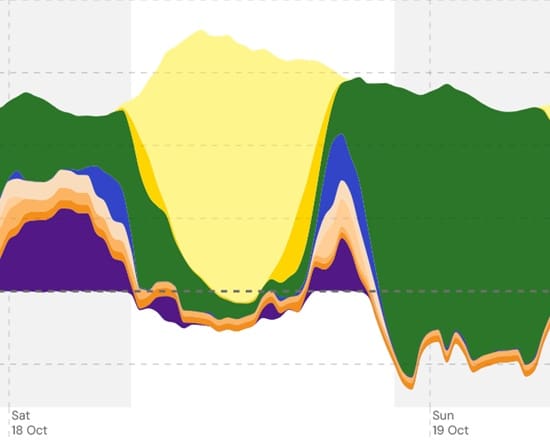
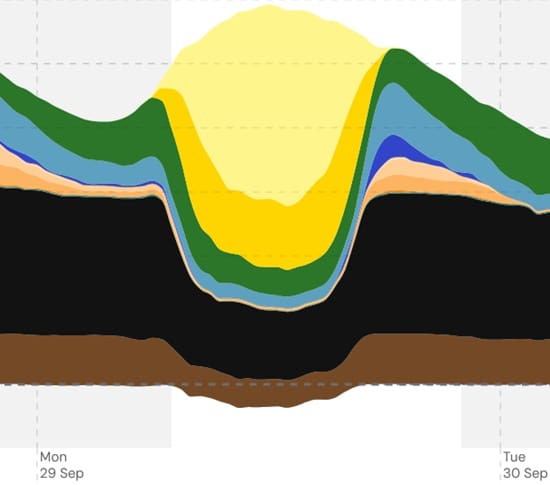
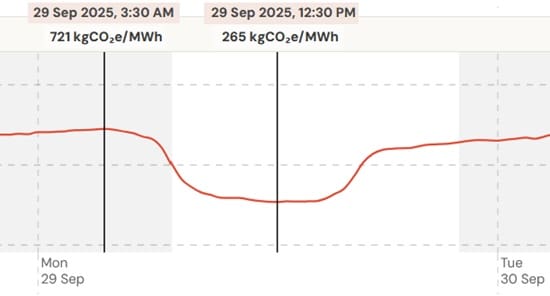
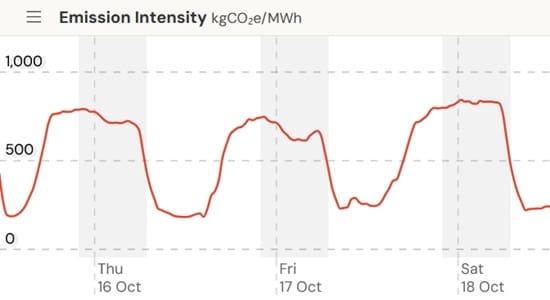
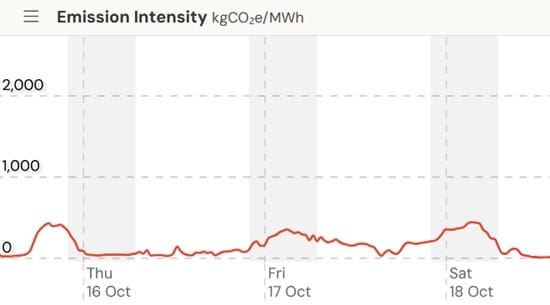
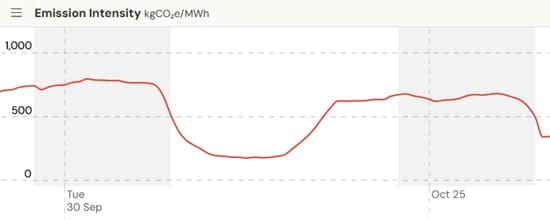
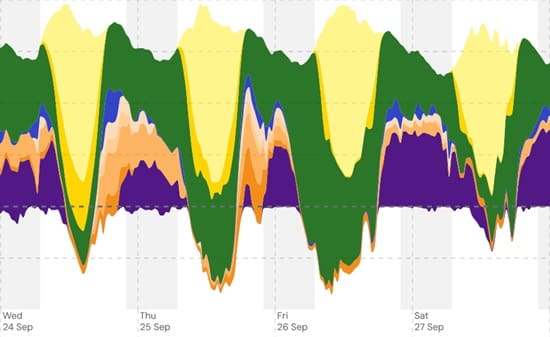
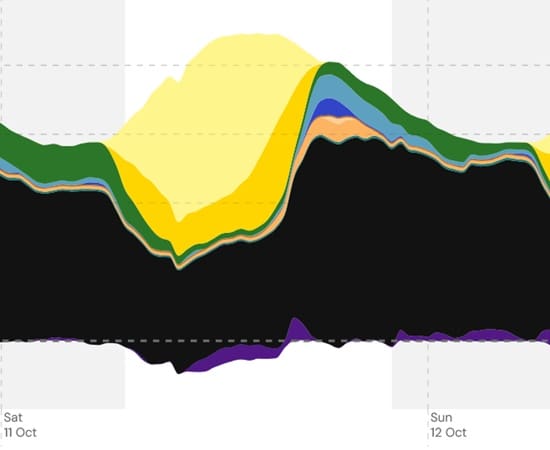
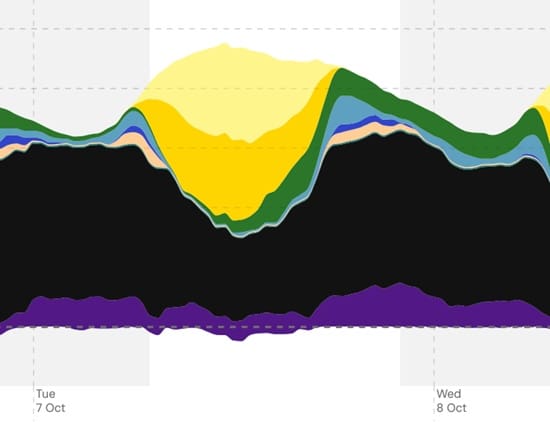
 RSS - Posts
RSS - Posts


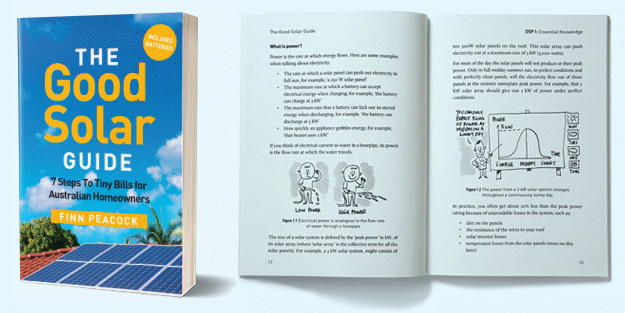
Been running our house off Solar+Battery for nearly a year now on Globird VPP, exporting our excess during the evening peak demand. Win/Win.
Do the blue areas on the Open Electricity charts cover only utility-scale batteries (which are likely required to report their operating parameters), or do they also include energy from home batteries (maybe collected via smart meters or estimated somehow)?
I seem to recall in the early days of these charts rooftop solar wasn’t plotted as it couldn’t be “seen” by the system, the impact would be simply to reduce domestic demand (and therefore coal / gas generation at the same time.
Open Electricity only appears to show large grid-scale batteries at this time:
https://docs.openelectricity.org.au/guides/batteries#how-openelectricity-splits-bidirectional-units
While they currently dominate, that’s rapidly changing.
Update: Added a footnote to the blog post to make this clear.
So do the stats not include (or under-estimate) self-consumption – home solar charging a battery for consumption at night?
Apparently not at the moment, but I guess they’ll account for it in the future, as it’s going to become an important part of the energy picture.
But all the residential battery suppliers know what their fleet is doing. Sungrow e.g. has that information by aggregating all the iSolarCloud information. Do none of these companies want to brag about how well their customers are collectively using said manufacturer’s equipment?
I think the difficulty is Open Electricity is going by information made public by the AEMO. While they supply a considerable amount of information, it doesn’t cover this.
This all sounds very logical. If it makes economic sense, as suggested, why are there no retailers offering plans that support the concept?
Marketing and commerce – they know their customer and they also know their own business. The retailers offering cheap overnight rates are often gentailers who also own coal stations. They have a much bigger incentive to encourage people to buy power from them overnight when they are the main ones selling than during the day when theres more competition. Also EV owners whose cars are home during the day and probably using their own solar so are getting a discount anyway – they are less attractive commercially even if the wholesale market is pretty cheap at that time. Retailers are not primarily motivated to save you money – they are motivated to be profitable. If the market administrators dont set the rules to encourage the desirable outcome then the retailers arent necesarily going to do it either.
I have occasionally charged my battery overnight deliberately, if the “Amber” purchase price was so low that nobody but me would be making a profit from reselling it later. Amber has done this in fits and starts occasionally when the overnight wholesale grid price is low enough for a quick buck in the morning.
Apart from not being able to stop this behaviour from Amber, would I even want to when a generator or all of them just want to dump power at a loss?
If night time wholesale prices were very low then coal power stations wouldn’t be making much money from the electricity they sell. Also, high wind output can result in low emissions at night and wind being curtailed, so charging your battery then would be unlikely to contribute to emissions. So charging when Amber says electricity is dirt cheap should definitely increase emissions less than just regularly charging a battery from a night time off-peak rate.
This is one of the gripes I have with Amber (as an otherwise generally satisfied customer) – that you cannot set some parameters such as “no overnight charging please” in SmartShift (their quasi-VPP setting). Related, is wanting to be able to set my own maximum buy and minimum sell rates so that I am guaranteed a spread of 15c/kWh, because this is the LCoS for my battery so I am kinda losing money with anything less than that 15c
Yes but I am highly suspicious off bes systems being built in the boonies adjacent to coal fired power stations. I think I have well founded suspicions as to how those are going to be charged…. Like the one near Kogan CK in Qld…
Some good news there is big batteries get built by coal power stations because that’s where the transmission capacity is. It’s often the best place for them.
So batterries directly reduce emission only if there is significant curtailment of renewable generation. While common in SA, this is much less common in Victoria.
Over supply as evidenced by negative prices in Victoria requires both high renewable generation and coal stations that continue operating. AEMO gives Victorian generation as 61% brown coal for the last year. If that shuts down, we can add a lot of solar before curtailment becomes significant here. Yes, it will happen, but not for a while yet.
While SA is ahead, there’s still plenty of curtailment happening in VIC. It looks like it has been happening every day lately.
A while back SQ had an article where SAPN gave a figure of curtailment by export limit to home solar systems on the basis of their trials, and I think they said that 5% of the time that curtailment would occur. Given that pv does not operate at night and does not provide much power early or late in the day, one could assume that while 5% of the time curtailment could occur, this could well amount to 7kwh of curtailment daily (midday 1 1/4 hours of curtailment on a 6.6 kw pv system) which is 28% of potential export limited on averages over the year, but on the basis of summer days yielding more energy and winter with no curtailment we might actually be curtailed 2 1/2 hours daily in summer (and none in winter), meaning closer to 50% of our total potential energy is curtailed.
Another reason to get a big home battery and large inverter to make sure we can quickly charge with our surplus.
Toggling on utility solar and wind curtailment on OpenElectricity graphs (either a recent feature or one I am late to) makes me think it is considerably more than 2% these days.
And if that is true, this article could also be read as part of a very strong case for extending the government battery rebate scheme to non-solar homes. On a wholesale tariff (Amber), in the peakier priced states at least, you can definitely break even on daytime imports and covering costs with about 10-20kWh of peak price exporting (with a decent price window of around 2 hours, 20kWh only if you can export at up to10kW).
Note that OpenElectricity curtailment shows the combined total of economic and technical curtailment, whereas Ronald was just saying economic curtailment was 2%.
But regardless, I think Ronald made a (rare) mistake. According to AEMO’s QED, about 10% of utility solar was economically curtailed in 2024.
Yes with the current market, a battery only is definitely a viable prospect for someone who can’t have panels, pity they can’t get the rebate.
If they ever fix the market you might not have as great an advantage, but given that they have deliberately designed this market to allow power companies to fleece consumers to pay for the infrastructure required, I can’t see them fixing it anytime soon.
Always love reading your articles Ronald. Some excellent advice about batteries in this one!
But I think you’ve made a mistake comparing utility batteries with residential ones.
Most utility batteries are averaging close to 1 cycle per day, which I suspect is probably more than a typical new 20 kWh residential battery.
Let’s say a utility battery is 120 MW / 240 MWh. if it averages one cycle/d, then average output is 240 MWh/24h = 10 MW, and its capacity factor is therefore 10/120 = 8.3%
Hi David,
Thanks for reading and providing input, it’s a real pleasure to know we’re held in such regard by experts like as yourself.
And I’d also like to express sincere thanks for the work you do on the OpenNEM simulation. It’s such a great resource to refer the naysayers to when they’re railing about what can’t be done.